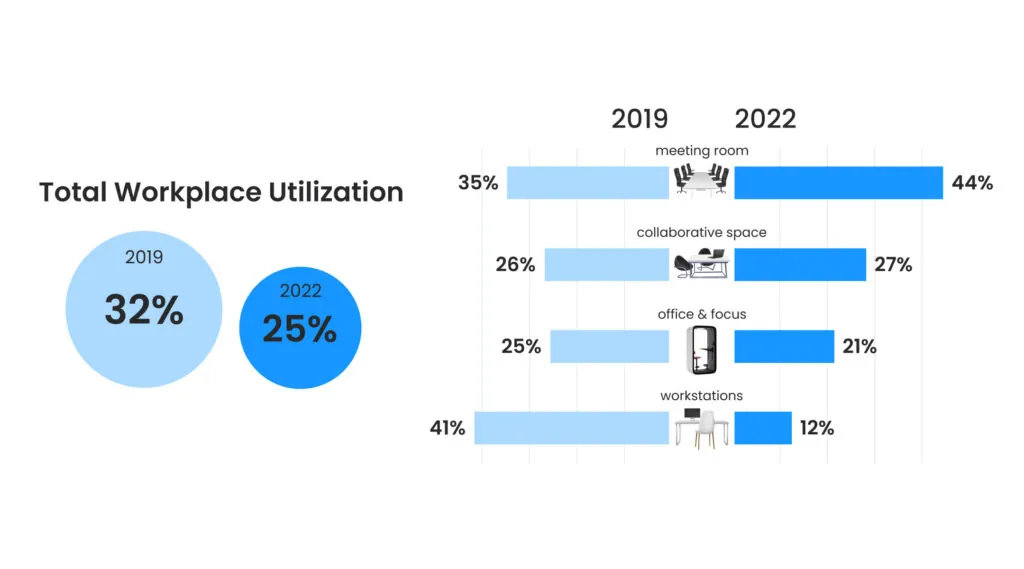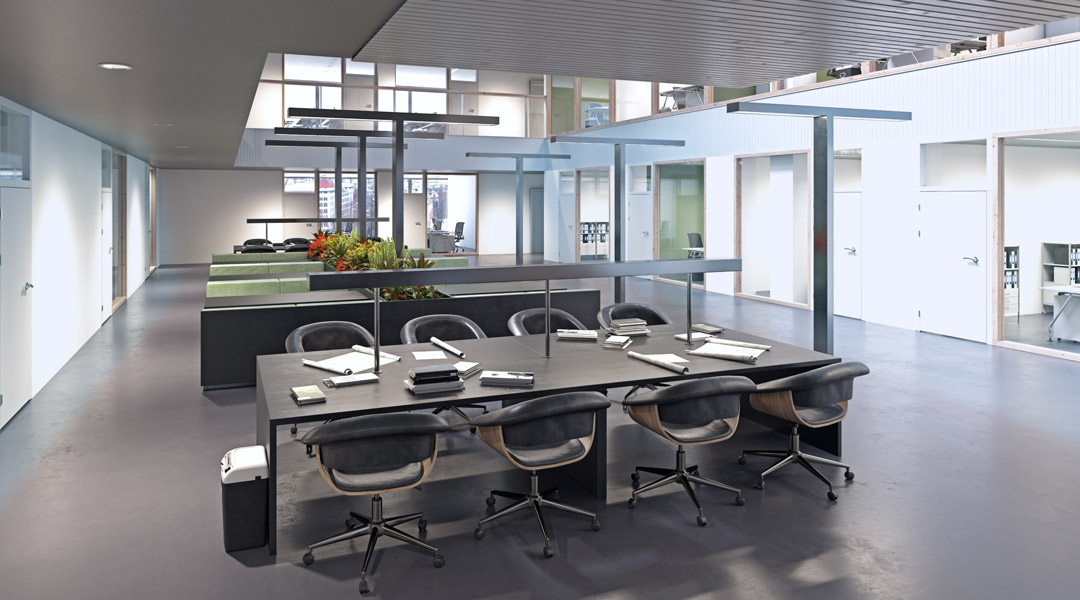
3-30-300 Rule and ROI
When it comes to selling a product, ROI is easy to visualize by simply comparing expenditure to profit—but what about estimating returns on your actual workspace? Office space is a company’s second largest cost behind people, and managers tasked with improving workplace utilization often have little reference for what drives productivity and thus makes workspace truly profitable. In these cases, the 3-30-300 rule can be a useful tool as it illustrates the relationship between facility management costs per square foot and which aspects can be modified to justify your investment in operations, real estate and people.
What Is the 3-30-300 Rule?
The 3-30-300 rule was originally coined by JLL and provides a framework for a company’s costs per square foot of workspace. For every $3 spent on utilities, $30 is spent on real estate, and $300 is spent on payroll. Of course, these numbers aren’t the same from business to business, but the ratios and relationships between each component provide a workable breakdown of a company’s costs. And, even more importantly, it can function as a guide for which sectors would benefit most from investment or cost-saving measures.
For example, if a company saved 20% on utilities with more efficient lighting, 20% on rent by downsizing, and increased productivity by 20% with a modern office design, then that company would save $.60 on utilities, $6 on rent, and $60 on employee costs for a combined return of $66.60.
How The 3-30-300 Rule Can Impact Workplace Costs?
Applying the 3-30-300 rule can have a huge impact on workplace costs by providing facilities managers with specific areas of investment to focus on with an estimated dollar amount baked into the formula. In practice, the rule can look like:
Better Energy-Efficiency
Smart office technologies and modern office design can all have cumulative effects on the cost of utilities. Offices with more natural light, for example, both cut down on energy usage and reduce eye strain in employees. Efficient HVAC systems can divert energy to areas of the office that are currently in use and avoid heating or cooling empty space for substantial savings. Even investments in solar or other renewable energy sources can be applied at scale.
Right Sizing the Portfolio
Finding real estate that is appropriately sized and in the right market is crucial to cutting back on excess rent costs. Utilization audits, smart seating plans, and hybrid work schedules can all impact the amount and kind of space required by your company to produce the same results while saving costs on excess space.
Putting People First
However, not all factors of the 3-30-300 rule yield the same returns. Based on the ratios in play, even a modest improvement in employee efficiency is far more valuable than huge savings in utility costs. And, inversely, savings in utilities or rent that come at the expense of employee productivity may not be worth it in the long run.
For example, a company may choose to downsize to a smaller office to save 10% on rent, but the new location means their employees need to drive further to get to work. If the increased commute results in even a 2% drop in productivity, that company is effectively losing twice as much as it intended to save.
The most important takeaway from the 3-30-300 rule, then, is that the greatest impact on facilities management costs by square foot comes from investing in workers, and creating a people-first workplace environment has the dual benefit of increasing worker satisfaction and optimizing the budget. Some of the ways that companies can invest in increased productivity include:
Considerations in Projects
When considering cost-saving measures, weigh employee satisfaction more heavily than short-term savings. Cheaper office furniture might seem economical when looking at net costs, but if uncomfortable seating or cramped workspaces result in less happy or productive employees, the cumulative cost will outweigh the benefits. If the project benefits the 3 or the 30 at the expense of 300, it’s important to offer constructive feedback or alternative options—especially when considering the overall success of the organization.
Health & Wellness
The correlation between employee comfort, general satisfaction in the workplace, and productivity is well-documented, and investing in the first two can see returns in the latter. Certain organizations like the WELL Building Standard are leading the nation in healthy building certification with an emphasis on the core components that influence worker productivity: air, water, nourishment, light, fitness, comfort, and mental health. WELL certification may require significant investment to attain, but has proven effects in diminishing absenteeism and strengthening workplace culture.
However, people-first management principles can also be attained through more simple means. Certain office layouts have been proven to support productivity, for example. Even adequate heating and cooling, natural light levels, and ambient noise management can all contribute to a more comfortable work environment that encourages employee productivity.
How Space Impacts Productivity Potential
Even the workspace itself can impact productivity. Poorly managed or inefficient space can create both logistical problems and poor employee satisfaction while in the office, making optimal space utilization an often overlooked facet of employee efficiency. For example, “Ghost meetings,” or meetings that are scheduled and then aren’t attended, can result in up to 30 hours of wasted employee time per month.
Improperly managed space can also leave employees feeling either cramped or isolated in their work stations, make for awkward or redundant foot traffic patterns, create bottlenecks, or leave high-use areas of the office perpetually cluttered. These spatial inefficiencies have been shown to interfere with employee collaboration and workplace satisfaction, resulting in drains on both productivity and usable rented space—the two greatest factors of the 3-30-300 rule.
How to Estimate the Costs of Vacancies?
In fact, wasted space can be a huge liability to company assets, costing companies thousands to millions of dollars per year. The average cost of a workstation per year is $10,000 in the United States. This cost typically includes real estate, utilities, technology, furniture, and more. If an office campus hosting 8,000 employees and 5,000 desks has an average daily vacancy rate of 18% or 900 desks (pre-covid R-Zero average), then the annual vacancy cost is $9M. This cost is nothing to bat an eye at and gives companies an extremely valuable benchmark against how to optimize their space. For a more in-depth breakdown of what vacancies are costing your specific company, you can use R-Zero’s online estimate tool or request a demo to discover how to put this into practice in our analytics.
R-Zero Improves Productivity with Real-Time Data
Smart office technology from R-Zero offers solutions to the challenges of inefficient space utilization or the “30” element in our rule. R-Zero’s anonymous occupancy sensors create workplace analytics, measuring variables like peak-traffic times, the average time that a space is in use, vacant workspaces, and even the number of people using a meeting or conference room at a given time—all without collecting any identifying information to protect your employees’ privacy.
Using R-Zero’s sensor data collection, facilities managers and real estate leaders can boost employee productivity by identifying and addressing inefficient space utilization. Simply put, instead of wasting time looking for usable workspace and struggling with ineffective meeting schedules, R-Zero real-time data can help your employees streamline their workflow for a more productive and convenient day at the office.
Applying the 3-30-300 rule can help managers identify the true costs of their workspace, and plan for the kinds of investments that will create real value for their companies–but it also illustrates the simple fact that people make a business profitable. By investing in smart office technology and making your workspace work for your employees instead of the other way around, business owners and managers can see significant ROI in both real estate and employee satisfaction.
More posts you might like
-
2022 Benchmark Data. Who Is Measuring What?
Hello Friends, Who ended 2022 where you thought you would? Well, many of our customers did not and some ended the year finding themselves in the middle of surprising new trends. We’d like to share with you some of our 2022 sensor-based Utilization Benchmark Data. If you are curious about any of these key findings, […]
-
Right-Sizing your Portfolio with Peak Metrics
A new way of working is here to stay. What started as a pandemic-era necessity has rapidly become the norm in many industries, including many fortune 500 companies and global corporations. Studies have shown that 73% percent of employees say they need a better reason to go into the office than just company expectations. It’s […]
-
Top 8 Essential Office Space Utilization Metrics & Their Applications
One thing we know for sure is that the future is uncertain. Instead of being stuck in a daze of wonder, real estate professionals are grounding their planning processes in data. So long as they have data to guide them, they can plan for hybrid work environments that are bound to change over time. Fortune […]


